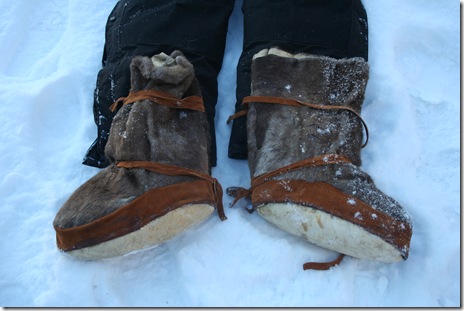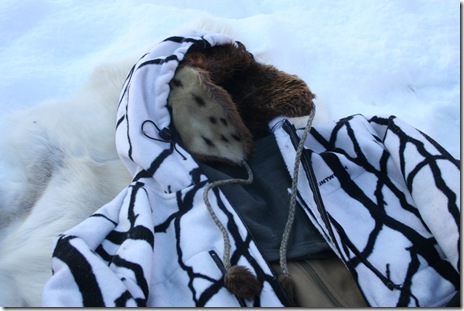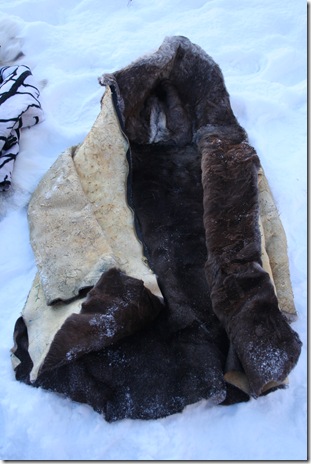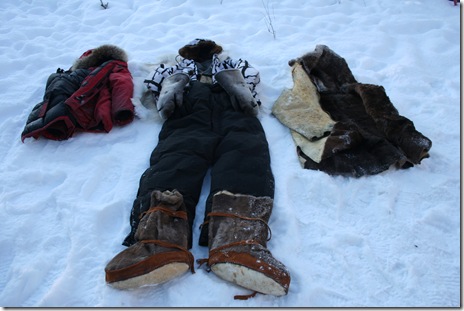January 28, 2010
How To Dress On An Arctic Expedition
Just picture it. You’re on an isolated, rocky beach and the sun is shining. The breeze picks up and in the distance you see a giant rolling wave making it’s way toward the shore. As the wave crashes against the beach, it brings with it a screaming 80 mph gale. You’re not in Hawaii, you’re on the Arctic coastline and that wave isn’t the kind you ride on a surf board. It’s a wave of blowing snow and treacherous cold…it’s a blizzard. And you’d better darn well be wearing more than your swimsuit!
But what exactly should you wear when there’s a –100 degree wind chill? Well, Joe’s been there and done that for almost 30 years and he’s got his wardrobe down to a science. You don’t need fancy schmancy, overpriced and overrated “top of the line” gear to stay comfortable. In this post, we’re going to show you how to do it!

The number one rule of cold-weather clothing is that the fabric must be soft. Denim is a big no-no! It’s too stiff. Soft, flexible fabric is ideal. Joe’s favorite choice is fleece. For the first layer or two, he wears fleece shirts (hooded if possible) and fleece pants.

For the feet, Joe likes some hand-sewn sheep skin slippers (in the photo above). He doesn’t even bother with socks. He wears the slippers inside a pair of caribou fur mukluks (which we also sew by hand). The mukluks are double-layered and made with plenty of extra room. The last thing you want is to wear tight fitting footwear! Tight boots hinder blood flow to the feet, and that’s a recipe for disaster, so expect to wear at least two sizes larger than you would normally. Don’t be fooled by claims that a company’s boots are “rated to –XX degree.” Most store bought boots are stiff and have rigid soles which violates the rule of softness! They’re not all they’re cracked up to be. If you don’t want to engineer your own pair of soft mukluks, you might be able to find some old school fur mukluks on ebay.

Equally important to loose fitting footwear is loose fitting mitts. The best way to prevent cold hands in the arctic is to wear one pair of insulated gloves inside of some kind of animal fur over-mitt. The picture below shows seal skin over-mitts, but sheep skin and caribou skin are excellent choices as well. If all else fails and your hands and feet just won’t cooperate, a little modern technology can go a long way! Heat Factory products are a great way to warm up frosty extremities in a hurry!

They say most of your body heat is lost through your head, so we mustn’t forget to wear a fleece or wool stocking cap. On really cold days, you might consider an animal fur, aviator-style hat. The one shown below is made of seal skin, but any animal fur will suffice. Also, pull those hoods up to help block the wind and keep your breath off your face a bit. And while you’re at it, you may as well wear a fleece neck gaiter because at –80 degrees, any exposed skin is likely to freeze in a jiffy!

Over the fleece, you must have a wind barrier, so a regular parka will do. Just make sure it has an animal fur ruff. Sorry, PETA, but synthetic ruffs just don’t cut it and you wouldn’t want a guy to lose half his face to frostbite would you? You also need coveralls to block the wind from your lower half! We get Classic Alaska products from Big Ray’s.

On an insanely cold day, you can top the torso off with a caribou fur parka. No wind can penetrate it whatsoever, and chances are, it’s a bit overkill, especially if you’re snowshoeing or skiing in front of a dog team. But it sure comes in handy sometimes when Jack Frost isn’t just nipping at your nose, but he’s coming at you with a chain saw!

So here’s your ensemble!
Stylish? Not exactly.
Warm? Absolutely.
Lightweight? You wouldn’t believe it!


